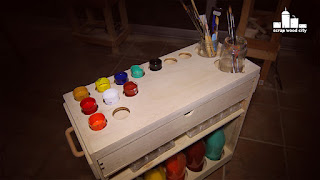Looking at an old rusty fire extinguisher I had, an idea of a DIY musical instrument came to me. I also had a pine bed I found in the garbage. So I decided to combine wood and metal and a create a unique four string instrument.
First of all I cleaned and emptied the fire extinguisher. I then used the angle grinder to cut out out the section I needed. I also used the angle grinder with a sanding disc, to remove the paint and the rust.
I then cut the bed to boards with a hand saw, I jointed and planed the pieces using my planer-jointer machine.
I then cut the two blocks of the body on the bandsaw. I sanded them on my belt sander. On one block I used the bandsaw to create the female dovetail. I cleaned that up with a sharp chisel.
I then glued the blocks on the body with two part epoxy. I also added a few screws for extra strength. I then prepared and glued two small pieces on the sides. Those provide extra glueing surface for my guitar’s top. I trimmed the excess wood with my block plane. I then jointed my body’s face by sanding it over a flat board with glued sand paper on it.
The top needs to be really thin. To plane such a thin board, I glued the piece on a piece of plywood with a few drops of hot glue and passed it through the thickness planer. I saw that technique in a video made by Nick Ferry.
I glued the two braces under the top. After the glue dried out, I used a chisel to shape them at my likeness. Using a forstner bit I bored the sound hole. I glued the top on the body. To clamp that odd shape, I made a few curved blocks.
Using the bandsaw I cut as much material as I could out of the neck’s male dovetail. I finished the job with a handsaw and a chisel.
The neck is glued with the headstock at an angle. To create that angle I used a tapered block glued on the neck and made a rip cut on the table saw. I used the bandsaw to cut the back of the neck. I glued the headstock with the neck. The piece of the neck I removed on the bandsaw was planned flat and used as the fret board.
On the table saw I used a cross cut sled to create a groove under the fretboard. I did that with several passes. This helps the top to sit under the fretboard.
My instrument’s scale from nut to bridge is 59,5cm. I used an online fret calculator to measure the fret positions. I marked the positions of the frets. I cut thin slots with a miter box. I then used a V file to open up the slots. This increased my glueing surface. I then glued the fretboard on the neck. I also used two wooden pins, to prevent the fretboard from sliding around during the glue up. I used this pins as fret position guides. I trimmed them flush with a flush trim saw after the glue dried.
I shaped the neck using a block plane and a spokeshave. The difficult to reach areas I shaped with a rasp. I moved to a file and finished with sandpaper.
I used nails as frets. I cut the heads with the angle grinder. I secured the fretboard on my vise. I used a spirit level to make sure it was flat to prevent the glue from dripping. I then glued the frets with epoxy. After the epoxy dried I tried to trim the frets flush with the angle grinder. This created a lot of heat and the epoxy melted in few frets and popped them out. So I cleaned the slots again and reglued the frets. This time I had already cut them to size before glue up.
I cut a scrap metal piece with the grinder to act as string holder. I made the holes needed on the drill press while lubricating the drilling process. This helps me keep the drill bit sharper for much longer.
I then made the bridge out of maple and plexiglass. I routed the slot of the bridge using my router table. I shaped the plexiglass of the neck and bridge using a file and sand paper.
Using a large sanding block I leveled the frets. I polished them with steel wool. I buffed them using my rotary tool with a buffing disc and polishing compound.
I glued the neck on the body.
I installed the keys, the string holders and the string guides.
I added strings, tuned it up and my little DIY guitar was ready for some blues!






























